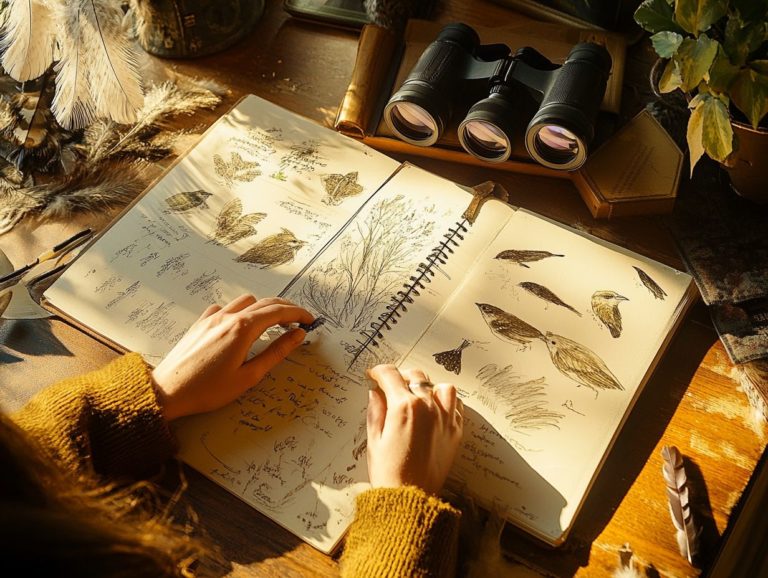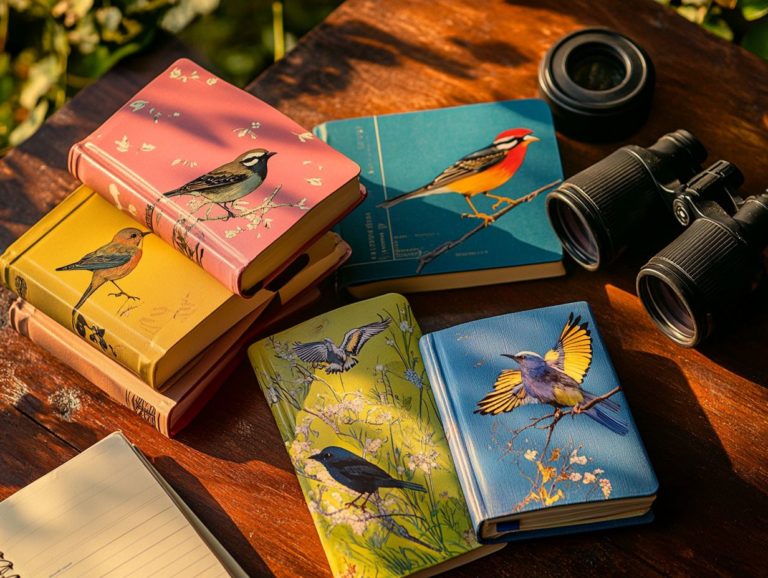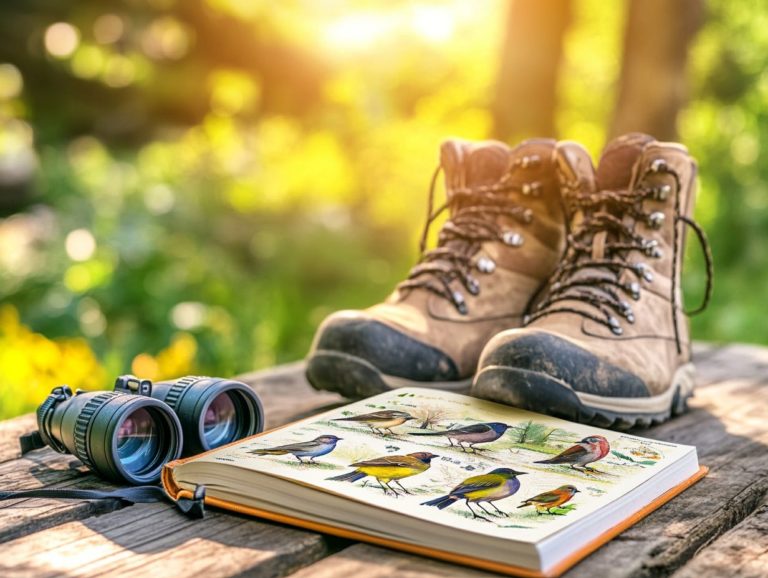Field Guide Features that Make Birdwatching Easier
Birdwatching transcends mere leisure; it s an immersive journey into the marvels of nature. It encompasses the study of bird taxonomy.
Whether you find yourself as a curious beginner or a seasoned birdwatcher, possessing the right tools and knowledge can significantly enhance your experience.
This article delves into essential equipment, such as binoculars. It highlights key features to consider in printed guides and offers valuable tips for effective bird identification.
It also addresses common pitfalls to avoid. Additionally, it presents identification resources designed to enrich your birdwatching adventures.
Embark with us as we uncover the essentials for spotting and appreciating our feathered companions. Together, we will explore bird songs and behaviors!
Contents
- Key Takeaways:
- Essential Equipment for Birdwatching
- Features to Look for in a Field Guide
- Advanced Features for Experienced Birdwatchers
- How to Use a Field Guide Effectively
- Common Mistakes to Avoid in Birdwatching
- Additional Resources for Birdwatchers
- Frequently Asked Questions
- What are some important features to look for in a field guide for birdwatching?
- Can a field guide for birdwatching be useful for beginners?
- How can a field guide help identify different types of birds?
- Are there field guides specifically designed for different regions or countries?
- What other features should I consider when choosing a field guide for birdwatching?
- Can a field guide for birdwatching be used on a digital device?
Key Takeaways:

- Grab high-quality binoculars to supercharge your birdwatching adventure!
- Choose a compact, user-friendly field guide for easy bird identification!
- Utilize digital guides and identification apps to expand your knowledge and improve your skills!
What is Birdwatching?
Birdwatching, or birding, invites you to observe birds in their natural habitats. This can be in bustling urban areas or serene wild locations across North America.
It beautifully merges outdoor exploration with a passion for wildlife. You can connect with nature while identifying a myriad of bird species through the use of birdwatching journals and field marks.
For beginners, birdwatching is an engaging journey that fosters a deep appreciation for bird life. It also contributes to projects where everyday people help scientists by tracking bird sightings and behaviors.
As you step into parks, forests, or even your own backyard, you’ll find diverse environments perfect for discovering the melodious bird songs that fill the air. This practice brings peace and excitement as you discover the fascinating roles of various bird species.
Experienced birders enjoy these outings and refine their skills in recognizing subtle differences in plumage and calls. By participating in citizen science projects, both novice and seasoned bird enthusiasts play a pivotal role in gathering data that supports conservation efforts.
Essential Equipment for Birdwatching
To fully immerse yourself in the rewarding hobby of birdwatching, possessing the right equipment is essential. It enhances your overall experience and aids in accurate bird identification.
Key items to consider are:
- High-quality binoculars, which provide optimal viewing.
- A reliable field guide, like the Sibley Guide, Peterson Guide, or Kaufman Guide, to assist you in identifying various bird species.
- A birdwatching journal that will prove invaluable for tracking your sightings and observations.
Binoculars and Other Necessities
Choosing the right binoculars is vital for your birdwatching adventures. They enable you to observe birds from a distance without causing any disturbance.
Opt for high-quality models like the Celestron Outland or Nikon Monarch M5; they provide exceptional clarity and light-gathering capabilities. This ensures that every moment spent tracking birds across various habitats is truly engaging.
When selecting your binoculars, pay attention to features such as magnification and field of view. These factors dictate how close the birds appear and how much of the surrounding area you can see while focusing on a particular bird.
Weight is another key factor, especially during lengthy observation sessions. Lightweight options can significantly enhance your comfort and ease of use.
Beyond binoculars, consider adding field guides and birdwatching apps to your toolkit. These resources can enrich your experience by providing essential information about local species and their behaviors.
Features to Look for in a Field Guide
When choosing a field guide for bird identification, consider several key features. Look for aspects like illustrations versus photographs that enhance your bird watching usability and effectiveness.
Renowned options like the Sibley Guide or the Kaufman Guide offer detailed illustrations, identification photos, and range maps. For more insights, check out field guides: the art of birdwatching simplified. These elements are crucial for facilitating accurate and effortless comparisons among various bird species, ensuring you have the best tools at your disposal for your birdwatching adventures.
Size, Layout, and Content

The size and layout of a field guide are crucial for your birdwatching experience. An intuitive design allows for swift identification in the field. A well-structured guide, highlighting the top features to look for in a bird field guide, organizes bird species by region and includes a visual index, making it easy for you to access detailed information quickly.
This thoughtful organization saves you time and boosts your enjoyment when you spot a bird! A compact size ensures that the guide fits effortlessly into your backpack or pocket, while clear illustrations paired with descriptive text enable you to grasp not just what you’re seeing but also its behavior and habitat. Utilizing field guides to enhance your birdwatching experience can make all the difference.
Having dedicated regional guides enriches your learning journey by showcasing localized species, helping you foster a deeper connection with your environment. This tailored approach significantly influences how effectively you engage with the avian world around you.
Advanced Features for Experienced Birdwatchers
For the passionate birdwatcher yearning for a richer connection with avian life, understanding the importance of field guides in bird watching can truly elevate your experience.
These sophisticated tools offer access to scientific insights, which means facts and data about birds. You ll also receive real-time updates on bird sightings and advanced identification capabilities, making your birdwatching endeavors not only more efficient but also immensely enjoyable.
Digital Guides and Other Tools
Digital guides and online resources, such as All About Birds and eBird, transform the birdwatching experience. They grant you instant access to comprehensive databases and invaluable community insights. These identification apps enable you to document your observations while connecting with a broader network of birdwatchers for collaborative learning.
Additionally, tools like Merlin Bird ID offer user-friendly interfaces that assist you in identifying species by simply answering straightforward questions about colors, size, and location. This interactive approach enhances your confidence in identifying birds and fosters a sense of belonging within a passionate community.
Resources like Bird Note and various online forums promote knowledge sharing, making it easier for both newcomers and seasoned birders to enrich their experience. By leveraging these guides and tools, you can sharpen your observational skills and simultaneously contribute valuable data to conservation efforts.
How to Use a Field Guide Effectively
Unlock the full potential of your birdwatching adventures by mastering how to effectively use a field guide!
Effectively utilizing a field guide requires practice and a systematic approach to bird identification, particularly for those new to the captivating world of avian exploration. Exploring resources like field guides: building your birdwatching knowledge can enhance their overall birdwatching experience.
By familiarizing yourself with the layout of the field guide and employing strategies such as tracking birds through their habitats and behaviors, alongside using identification resources, you can significantly enhance your observational skills and deepen your appreciation for the fascinating diversity of birdlife. Utilizing how field guides can improve your birdwatching skills will also contribute to this experience.
Tips for Identifying Birds in the Field
Identifying birds in the field demands good observation skills and a keen eye for detail. You’ll want to focus on key field marks like plumage, size, and behavior. Also, tune in to the distinctive sings that each species sings. Mastering the use of binoculars, a tool to see faraway birds clearly, can elevate your experience, providing clearer views that make identifying various species a breeze.
To truly thrive in birdwatching, know the key features that distinguish species. It’s not just about the colors; patterns, bill shapes, and tail lengths are important too.
Also, don t underestimate auditory cues. Unique calls and whistles are invaluable tools for spotting birds that might be tucked away from sight. By using high-quality binoculars, you can scrutinize these features up close, deepening your appreciation for the birds around you.
And remember, capturing identification photos is a fantastic way to preserve those magical moments in the field. They ll serve as valuable references, helping you refine your identification skills over time.
Common Mistakes to Avoid in Birdwatching

Birdwatching offers a uniquely rewarding experience, yet common missteps like misidentifying species or neglecting essential gear can really take the fun out of birdwatching! Recognizing the significance of accurate bird tracking and utilizing the appropriate tools can greatly elevate your overall enjoyment of this captivating pursuit.
Embracing these practices transforms each outing into a truly enriching adventure, enhancing your connection with the avian world.
Misidentifying Birds and Other Errors in Birdwatching
Misidentifying birds is one of the most common challenges you might face as a birdwatcher. This can easily happen due to the similarities in plumage, size, or behavior among various species.
To sharpen your identification skills, it s crucial to recognize these frequent pitfalls. Many enthusiasts tend to rely solely on visual cues, often overlooking the distinctive sounds that can provide invaluable insights.
To sidestep these mistakes, familiarize yourself with the songs and calls of local birds. Often, these auditory signals can clear up any uncertainty you might have. Engaging with fellow birdwatchers and seeking advice from seasoned individuals can significantly enhance your knowledge.
Use apps or websites with advanced filtering options to make identification easier, ensuring that your observation experiences are both rewarding and accurate.
Additional Resources for Birdwatchers
As a birdwatcher eager to deepen your knowledge and forge connections with fellow enthusiasts, don’t miss out! Explore a treasure trove of resources waiting for you on various birding websites and online databases.
These platforms not only offer a wealth of information but also champion citizen science initiatives, inviting you to actively participate in the community while enriching your understanding of diverse bird species and their habitats.
Online Databases and Birding Communities
Online databases like eBird and Birds of the World are invaluable resources for you as a birdwatcher. They provide a platform to record and share your bird sightings while contributing to citizen science. Engaging with birding communities online nurtures your passion for avian life. It also facilitates a vibrant exchange of knowledge and collaboration.
These platforms also provide extensive tracking tools, detailed species information, and real-time data visualization. These are essentials whether you re a novice or a seasoned birdwatcher. By participating in these collective efforts, you can hone your observation skills, familiarize yourself with regional species, and glean insights from the experiences of fellow enthusiasts.
Citizen science projects that stem from these online networks play a crucial role in advancing bird study and conservation. They highlight the significance of every sighting you make. As you engage more through these channels, you contribute to a vast reservoir of data that helps map migration patterns, assess population health, and support biodiversity initiatives.
Frequently Asked Questions
What are some important features to look for in a field guide for birdwatching?

Some important features to look for in a field guide for birdwatching include:
- Detailed illustrations or photographs
- Organized index or table of contents
- Information on bird behaviors and habitats
Join these online communities now to enrich your birdwatching journey!
Can a field guide for birdwatching be useful for beginners?
Yes, a field guide can be useful for beginners as it provides basic information on identifying birds and their behaviors. For valuable insights, consider using tips for new bird watchers that include guides with clear and simple descriptions, as well as color-coded sections for easy navigation.
How can a field guide help identify different types of birds?
A field guide can help identify different types of birds by providing illustrations or photographs, detailed descriptions of physical characteristics and behaviors, and range maps showing where the bird can be found.
Are there field guides specifically designed for different regions or countries?
Yes, there are field guides specifically designed for different regions or countries. These guides include information on local bird species and migratory patterns, making it easier to identify birds in a specific area.
What other features should I consider when choosing a field guide for birdwatching?
Other features to consider when choosing a field guide for birdwatching include:
- Size and weight
- Durability
- Waterproofing
Look for a guide that is compact and can withstand outdoor conditions.
Can a field guide for birdwatching be used on a digital device?
Yes, many field guides now have digital versions that can be used on a smartphone or tablet, including options like the Merlin Bird ID app. These can be useful for birdwatching on-the-go and may have additional features such as bird calls and interactive maps.






